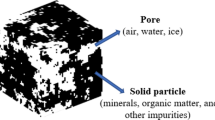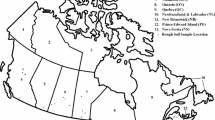Abstract
The thermal conductivity of the different soil components—mineral, liquids and air—varies across two orders of magnitude. Two studies are implemented to explore the role of contacts in heat conduction in dry granular materials. The first set of experiments is designed to elucidate heat transfer at contacts, and it is complemented with a numerically based inversion analysis for different local and boundary conditions to extract proper material parameters. Then, the thermal conductivity of dry soils is measured at different packing densities to address the relevance of coordination number and particle shape effects. Together, both studies confirm the prevailing effect of contact quality and number of contacts per unite volume on heat conduction in granular materials. Interparticle contacts and the presence of liquids in pores play a critical role in heat transfer, and determine the ordered sequence of typical thermal conductivity values: k air < k dry-soil < k water < k saturated-soil < k mineral.
Similar content being viewed by others
Abbreviations
- λ:
-
heat loss coefficient (s−1)
- ρ:
-
mass density (g m−3)
- ν:
-
poisson ratio
- A :
-
area (m2)
- a :
-
fitting parameter
- A c :
-
contact area (m2)
- cn :
-
interparticle coordination number
- C u :
-
coefficient of uniformity
- c v :
-
heat capacity (cal g−1 °C−1)
- d:
-
diameter (mm)
- D:
-
thermal diffusivity (m2 s−1)
- D 50 :
-
mean particle size (mm)
- FRd :
-
larger particle size ratio
- FRmass :
-
mass fraction
- G:
-
shear stiffness
- I :
-
electrical current (Ampere)
- k :
-
thermal conductivity (W m−1 K−1)
- k eff :
-
effective thermal conductivity (W m−1 K−1)
- L :
-
loss factor (cal s−1°C−1)
- M:
-
numerical modulus
- N:
-
normal force
- n :
-
porosity
- p :
-
fitting parameter
- q :
-
heat energy per unit time (cal s−1)
- R:
-
resistance (Ω)
- S:
-
saturation
- T:
-
temperature (°C)
- t :
-
time (min)
- V :
-
voltage (V)
References
Stein C.A. and Stein S. (1992). A model for the global variation in oceanic depth and heat flow with lithospheric age. Nature 359(6391): 123
Verhoogen J. (1980). Energetics of the earth, p. 139. National Academy of Sciences, Washington, DC
Miller, D.L.: Thermal design considerations in frozen ground engineering: a State of the Practice Report in Temperature Monitoring/Ground Thermometry, Prepared by the Technical Council on Cold Region Engineering of the American Society of Civil Engineers. Krzewinski, T.G., Tart, R.G. (eds.) pp. 53–71, ASCE: New York (1985)
Joshi R.C., Achari G., Horsfield D. and Nagaraj T.S. (1994). Effect of heat transfer on strength of clay. J. Geotech. Eng. 120(6): 1080–1088
Carslaw H.S. and Jaeger J.C. (1959). Conduction of Heat in Solids, p. 510. Clarendon Press, Oxford
Singh D.N. and Devid K. (1992). Generalized relationships for estimating soil thermal resistivity. Exp. Thermal Fluid Sci. 22: 133–143
Vargas W.L. and McCarthy J.J. (2001). Heat conduction in granular materials. AIChE J. 47(5): 1052–1059
Thalmann R.E. (1950). Thermal Conductivity of Dry Soils. University of Kansas, Lawrence, KS
Lambert M.A. and Fletcher L.S. (1997). Review of models for thermal contact conductance of metals. J. Thermophys. Heat Transf. 11(2): 129–140
Tang, A.-H., Cui, Y.-J., Le, T.-T.: Thermal properties of compacted bentonites. Can. Geotech. J. (2006) (in press)
Weidenfeld G., Weiss Y. and Kalman H. (2000). A theoretical model for effective thermal conductivity (ETC) of particulate beds under compression. Granular Matter. 6: 121–129
Yun T.S. (2005). Mechanical and thermal study of hydrate bearing sediments, in School of Civil and Environmental Engineering, p. 179. Georgia Institute of Technology, Atlanta
Manohar K., Yarbrough D.W. and Booth J.R. (2000). Measurement of apparent thermal conductivity by the thermal probe method. J. Test. Eval. 28(5): 345–351
Standard test method for determination of thermal conductivity of soil and soft rock by thermal needle probe procedure (ASTM D 5334–00)
Cho G.C., Dodds J. and Santamarina J.C. (2006). Particle shape effects on packing density, stiffness and strength—natural and crushed sands. J. Geotech. Geoenviron. Eng. 132(5): 591–602
Guyon E., Oger L. and Plona T.J. (1987). Transport properties in sintered porous media composed of two particle size. J. Appl. Phys. D: Appl. Phys. 20: 1637–1644
Santamarina J.C., Klein K.A., (2001) Fam M. Soils and Waves—Particulate Materials Behavior, Characterization and Process Monitoring, p. 488. Wiley, New York
Fletcher L.S. (1988). Recent developments in contact conductance heat transfer. J. Heat Transf. 110: 1059–1070
Tarnawski V.R., Leong W.H., Gori F., Buchan G.D. and Sundberg J. (2002). Inter-particle contact heat transfer in soil systems at moderate temperatures. Int. J. Energy Res. 26: 1345–1358
Yagi S. and Kunii D. (1957). Studies on effective thermal conductivity in Packed Bed. AIChE J. 3(3): 373–381
Aduda B.O. (1996). Effective thermal conductivity of loose particulate systems. J. Mater. Sci. 31: 6441–6448
Williams J.A. (1994). Engineering tribology. Oxford Science Publ., Oxford, 488
Cote J. and Konrad J.M. (2005). Thermal conductivity of base course material. Can. Geotech. J. 42: 61–78
Woodside W. and Messmer J.H. (1961). Thermal conductivity of porous media. I. Unconsolidated sands. J. Appl. Phys. 32(9): 1688–1698
Ye J., Kojima N., Furuya K., Munakata F. and Okada A. (2002). Micro-thermal analysis of thermal conductance distribution in advanced silicon nitrides. J. Therm. Anal. Calorim. 69: 1031–1036
Gangadhara Rao, M.V.B.B., N., S.D.: A generalized Relationship to estimate thermal resistivity of soils. Can. Geotech. J. 36, 767–773 (1999)
Marotta E.E. and Fletcher L.S. (1998). Thermal contact conductance for Alumimum and Stainless steel contacts. J. Thermophys. Heat Transf. 12(3): 374–381
Mirmira S.R., Jackson M.C. and Fletcher L.S. (2001). Effective thermal conductivity and thermal contact conductance of graphite fiber composites. J. Thermophys. Heat Transf. 15(1): 18–26
Kumar S.S., Abilash P.M. and Ramanurthi K. (2004). Thermal contact conductance for cylindrical and spherical contacts. Heat Mass Transf. 40: 678–688
Sridhar M.R. and Yovanovich M.M. (1996). Elastoplastic contact conductance model for isotropic conforming rough surfaces and comparison with experiments. J. Heat Transf. 118(1): 3–9
Farouki O.T. (1985) Thermal design considerations in Frozen Ground Engineering. In: Krzewinski T.G., Rupert G., Tart J. (eds). ASCE, New York p. 277
Hadley G.R. (1986). Thermal conductivity of packed metal powders. Int. J. Heat Mass Transf. 29(6): 909–920
Becker B.R., Misra A. and Fricke B.A. (1992). Development of correlations for soil thermal conductivity. Int. Commun. Heat Mass Transf. 19: 59–68
Gavriliev, R.I.: Thermal properties of soils and surface covers. In: Reston, D.C. (ed.) Thermal analysis, construction, and monitoring methods for frozen ground, vol. 492, pp. 277–294, ASCE, VA (2004)
Andersland, O.B., Ladanyi, B.: Frozen Ground Engineering. 2 ed. Hoboken, p. 363. Wiley, NJ, ASCE (2004)
DeVera A.L. and Strieder W. (1977). Upper and lower bounds on the thermal conductivity of a random, two-phase material. J. Phys. Chem. 81(18): 1783–1790
Sass J.H., Lachenbruch A.H. and Munroe R.J. (1971). Thermal conductivity of rocks from measurements on fragments and its application to heat-flow determination. J. Geophys. Res. 76(14): 3391–3401
Hashin Z. and Shtrikman S. (1962). A variational approach to the theory of the effective magnetic permeability of multi-phase materials. J. Appl. Phys. D: Appl. Phys. 33(10): 3125–3131
Hill R. (1965). A self-consistent mechanics of composite materials. J. Mech. Phys. Solids 13(4): 213–222
Gori F. and Corasaniti S. (2004). Theoretical prediction of the thermal conductivity and temperature variation inside Mars soil analogues. Planet. Space Sci. 52: 91–99
Author information
Authors and Affiliations
Corresponding author
Rights and permissions
About this article
Cite this article
Yun, T.S., Santamarina, J.C. Fundamental study of thermal conduction in dry soils. Granular Matter 10, 197–207 (2008). https://doi.org/10.1007/s10035-007-0051-5
Received:
Published:
Issue Date:
DOI: https://doi.org/10.1007/s10035-007-0051-5




